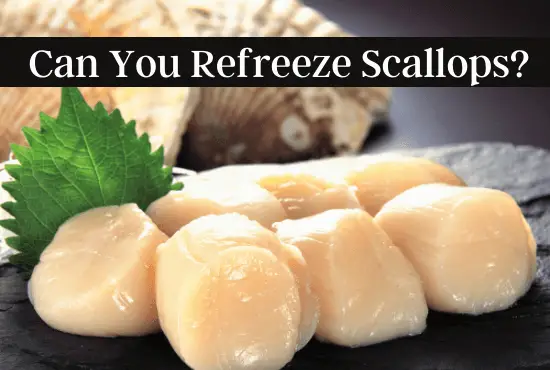Scallops have a mild, sweet flavor, and you might want to try them with friends. Once you thaw them and realize the amount is more than required, you might want to save them from spoiling and maintain their tender, buttery texture.
Refreezing the scallops can seem like an answer to all your troubles. But, what if it doesn’t work? Shall you carry on with the procedure?
You can refreeze both raw and cooked scallops as long as you thaw them in the refrigerator. Other defrosting methods do not go well with refreezing. Ensure to wrap them in a vacuum-sealed container or high-quality freezer bags. If you notice any discoloration on the scallops, avoid freezing them and toss them. Keep the air exposure minimum to decrease bacterial contamination.
Although seafood is a much-celebrated delicacy, it is hard to make them shelf-stable. The same is the case with scallops. This article is here to provide genuine solutions to your refreezing queries.
Table of Contents
Refreezing Dry/Uncooked Scallops
Scallops are rich in healthy fats and good for your body. The unique combination of delightful flavors makes them a widely loved seafood. However, it can be challenging to handle them as they can spoil quickly. Also, they are often highly prized, and you don’t want to waste them.
If you planned to create a dish using your frozen scallops and somehow changed your mind, you might be reluctant to store them again. No worry because you can refreeze the scallops but under some conditions. First of all, you should thaw the scallops in the refrigerator and not by other means. Secondly, you must defrost the scallops thoroughly. There can be chances of contamination.
By fulfilling these two conditions, you can successfully refreeze dry scallops. It is the best way to preserve them and keep them intact for longer durations. However, if you leave them in the open air for more than two hours, refreezing later might be of no use. Thus, it is crucial not to let them sit at room temperature unchecked as seafood tends to perish rapidly.
Refreezing Cooked Scallops
Either baked or fried, scallops taste otherworldly. When you finally decide to surprise your friends with the new seafood dish you create, scallops are at the top of the list. If you have any leftovers, transfer them back to the freezer. However, you have to be extra careful with the handling.
Wrap them securely in safety packaging before you refreeze them. The layers of protection will help keep them safe inside the freezer. Also, avoid refreezing them if exposed to open air for an extended period. In such a situation, it is better to discard them. They might have a microbial infestation.
Similarly, if your scallops are still hot, cool them down first. The fluctuation in the temperature can cause extreme freezer burns and destroy your expensive seafood. Once they reach the right temperature, you can finally pop them inside the freezer.
How Can You Safely Refreeze Scallops?
Refreezing scallops is easy, and you can do it by incorporating some steps into your freezing routine.
- Seal the scallops in a high-quality moisture-resistant wrap or freezer bag. It helps stop other food flavors from getting into your seafood.
- You can also go for vacuum-sealing if you have the device with you. Remove the excess air, so the chances of air contamination are minimal.
- For cooked scallops, cool them down beforehand. Once you do, transfer them into a heavy-duty freezer bag.
- Leave some spacing between them to avoid the scallops clinging against each other.
- Now, shift them to the coldest corner of the freezer to expose them to a consistent temperature. Set the freezer to 0 degrees F or below.
- Label the bag or container with the date of refreezing and store the scallops for a month or two.
Once you refreeze them, always check the freezer never runs out of power. If the power is gone for a longer span, it might affect the scallops, and you need to take them out and use them.
How Long Is It Good To Refreeze Scallops?
Scallops, like many other seafood varieties, are prone to degradation fast. Refreezing can increase their shelf life but at the cost of altering the overall quality. Over time, the scallops can lose their rich flavors and turn bland. They are still safe to consume if you do not mind a slight taste change.
If you thaw the scallops in the fridge and store them well, they can last for a month or maybe two. However, do pack them in safety packaging for an extended freezer stay. If you thaw scallops in a microwave or leave them at the countertop, you cannot refreeze them.
Also, if you leave them outside the fridge for more than two hours, the scallops might not survive another round of freezing. It is because bacteria start multiplying rapidly and refreezing afterward is useless.
Cooked scallops can spoil more quickly than raw versions. So, transfer them immediately to the freezer after thawing. The more you delay, the higher the chance they will lose their texture.
Defrosting Frozen Scallops; The Right Technique
When you decide to refreeze and avoid unnecessary food wastage, you need to plan. The refreezing process directly depends upon the method of your thawing. Thus, the preferred method is by defrosting the scallops in the refrigerator. Though it might be time taking, it decreases the occurrence of microbial infestation, and your seafood remains in a good state.
Thawing on the countertop or in a microwave is faster in comparison. But, these methods do not go well with refreezing. It is the abrupt temperature changes that make the scallops prone to degradation. So, it is better to place them in the fridge for defrosting.
If you need to avoid refreezing, you can opt for the portion freezing technique. Separate the scallops according to your serving amount and freeze them individually. It will help defrost what you require without affecting the remaining.
How Many Times Can You Refreeze Scallops?
Once you freeze scallops, they undergo a significant quality loss. So, if you freeze them repeatedly, they will further degrade. Refreezing them one time is okay to a certain degree, as you can revive the lost flavors by adding herbs and spices. However, if you exceed this limit, all you will have is bland-tasting scallops.
Besides the decrease in the taste, there is also a high chance of spoilage. Bacteria can still lurk inside the freezer and damage your seafood. So, when you consume them, you are at risk of developing stomach-related illnesses.
The frequent freezing can also snatch away many essential nutrients from the scallops. As an outcome, you are not getting any health benefits from them. Thus, it is better to discard the idea of constant refreezing.
Conclusion
As scallops come under the seafood category, they require proper storage. Refreezing can increase their shelf life and allow you to use them in the future. However, you have to put extra effort while storing them in the freezer once more.
It is crucial to thaw the scallops in the refrigerator, or they might not refreeze. Microwaving and hot water defrosting can leave them unfit for another freezing cycle. Also, cooked scallops should reach the right temperature before you refreeze them.
Raw scallops generally refreeze well if packed securely in sturdy containers. If not, they get freezer burns and lose many rich flavors. Thus, by following the correct steps, you can keep your scallops refrozen for a decent time.
Scallops are expensive and often rare to find fresh ones. Refreezing helps prevent food wastage and is an economical option. Also, it reduces the outcome of any health-related risks.



